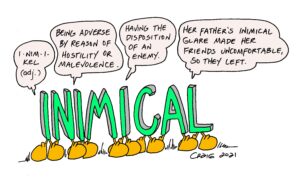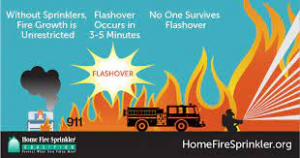Inimical Hazard: A Funny Little Word – Inimical

Inimical Hazard: A funny little word – inimical
Terin Hopkins
Public Fire Protection Specialist
National Fire Sprinkler Association

In the codes and standards world, words matter, even funny little words like inimical. When words like inimical are used, it is important to understand the meaning behind them, especially when paired with other words like hazard, as an adjective. This is elevating or describing the noun and indicates its quantity or extent potentially raising it to a higher level when used within the technical word of codes and standards.
When seeking to understand the words used in the technical world, we look to the codes and standards for guidance. Each one includes a chapter for definitions, which defines words used within that individual reference. The struggle is what to do with funny little words like inimical, that are not defined within the code or standard. Fortunately, both the codes and standards have a solution when this is encountered and states that the ordinary accepted meaning shall be used. The standard goes one step further and designates the source of those ordinary meanings, the Merriam-Webster’s Collegiate Dictionary, 11th edition.

Inimical – (Adjective)
- Being adverse often by reason of hostility or malevolence.
- Having the disposition of an enemy:
- Reflective or indicating hostility:
In contrast, the word hazard, is used 1,341 times throughout the standards as part of many definitions with the fire code defining a hazard, as a condition that presents the potential; for harm or damage to people, property, environment, mission, or cultural heritage. In this case, we are defining an inimical hazard as it relates to fire and the fire code further defines a fire hazard as any situation, process, material or condition that, on the basis of applicable data, can cause a fire or explosion or can provide a ready fuel supply to augment the spread or intensity of a fire or explosion, all of which pose a threat to life or property.
So here is our Inimical (fire) hazard – A HOSTILE, malevolent UNFRIENDLY situation or condition that can cause a fire hazard, augment the spread, or intensify fire threatening life and property.
In 2018 the Maryland Fire Prevention Commission designated all un-sprinklered high-rises as an inimical hazard. So, what are they indicating and why have they indicated it now?
It simple, they are indicating that decades old high-rise buildings, built before many of the requirements seen in modern-day buildings that lack modern day fire protection, are at a much higher risk or create a HOSTILE, malevolent UNFRIENDLY situation or condition that can cause a fire hazard, augment the spread, or intensify fire threatening life and property.
To understand the why now question, we only need to look at the UL-Fire Research Institutes Comparison of Natural and Synthetic Home Furnishing study on traditional fires vs. modern day fires. The studies abstract concludes there has been a steady change in the residential fire environment over the past decade. The most alarming, when addressing life safety in aging high-rise high-risk muti-family dwellings lacking modern day fire protection systems (un-sprinklered), is the increase in synthetic fuel loads.
Experiments conducted by the UL-FRI compared the changing fuel loads in modern day fires and saw significant changes in fire behavior in recent years. This new rapid-fire spread, exacerbated by the use of modern-day fire loads, contributes to the decrease in time to flashover.

Flashover is a Non- Survivable Event
These experiments show modern day living room fires have flashover times of less than 5 min, compared to the 30 mins with traditional fires. This decreasing window for egress is alarming and without occupant early warning-automatic fire alarms and automatic fire sprinklers controlling fires, providing extended time for occupant egress and time for firefighters to extinguish fires, creates tragic outcomes.
Home Fire Sprinkler Coalition Flashover Timeline

Today’s aging residential high-rise building, lacking basic automatic fire alarms and automatic residential fire sprinklers, are suffering significantly more challenging fires, not seen in past decades. More toxic smoke and fires that burn eight times faster than decades before, intensify the fire risk to life and property and clearly pose an Inimical fire hazard.
